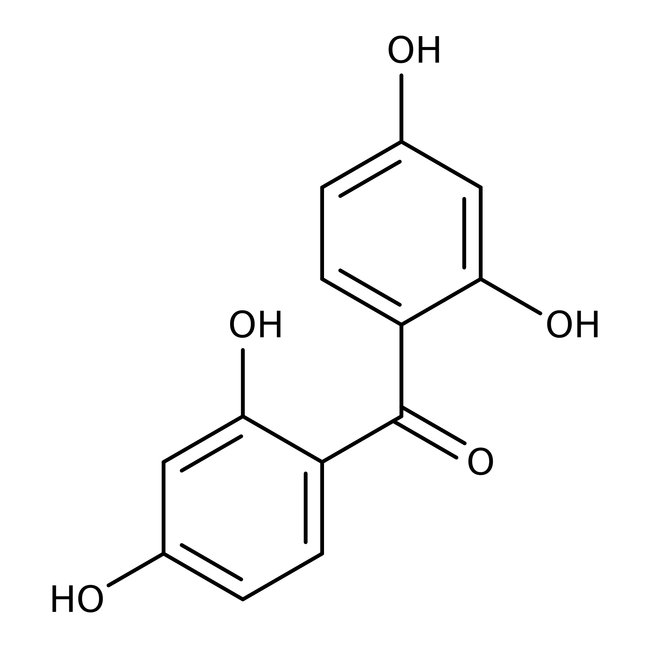Search Thermo Fisher Scientific
Thermo Scientific Chemicals
2,2',4,4'-Tetrahydroxybenzophenone, 98+%
CAS: 131-55-5 | C13H10O5 | 246.218 g/mol
| Catalog Number | Quantity |
|---|---|
| ALFA10237.14 | 25 g |
Catalog number ALFA10237.14
View Price:Sign InSign in to see your account pricing. Need an account? Register with us today.
Quantity:
25 g
Specifications
Chemical Name or Material2,2',4,4'-Tetrahydroxybenzophenone
CAS131-55-5
Health Hazard 1H302-H315-H319-H335
Health Hazard 2GHS H Statement
H301-H315-H319-H335
Toxic if swallowed.
Causes skin irritation.
Causes serious eye irritation.
May cause respiratory irritation.
H301-H315-H319-H335
Toxic if swallowed.
Causes skin irritation.
Causes serious eye irritation.
May cause respiratory irritation.
Health Hazard 3P261-P264b-P270-P271-P280-P301+P312-P302+P352-P304+P340-P305+P351+P338-P312-P330-P332+P313-P362-P501c
View more
2,2',4,4'-Tetrahydroxybenzophenone is used as the raw material of ultraviolet absorbers in cosmetics, plastics, resins and rubber. It is used as pharmaceutical intermediates and light-sensitive materials. It is also used as pharmaceutical adjuvant.
This Thermo Scientific Chemicals brand product was originally part of the Alfa Aesar product portfolio. Some documentation and label information may refer to the legacy brand. The original Alfa Aesar product / item code or SKU reference has not changed as a part of the brand transition to Thermo Scientific Chemicals.
Applications
2,2′,4,4′-Tetrahydroxybenzophenone is used as the raw material of ultraviolet absorbers in cosmetics, plastics, resins and rubber. It is used as pharmaceutical intermediates and light-sensitive materials. It is also used as pharmaceutical adjuvant.
Solubility
Slightly soluble in water.
Notes
Store away from oxidizing agents. Store in a cool, dry condition in well sealed containers.
2,2′,4,4′-Tetrahydroxybenzophenone is used as the raw material of ultraviolet absorbers in cosmetics, plastics, resins and rubber. It is used as pharmaceutical intermediates and light-sensitive materials. It is also used as pharmaceutical adjuvant.
Solubility
Slightly soluble in water.
Notes
Store away from oxidizing agents. Store in a cool, dry condition in well sealed containers.
RUO – Research Use Only
General References:
- Armin Zenker; Hansruedi Schmutz; Karl Fent. Simultaneous trace determination of nine organic UV-absorbing compounds (UV filters) in environmental samples. Journal of Chromatography A. 2008, 1202 (1), 64-74.
- Petra Y Kunz; Karl Fent. Estrogenic activity of UV filter mixtures. Toxicology and Applied Pharmacology. 2006, 217 (1), 86-99.



